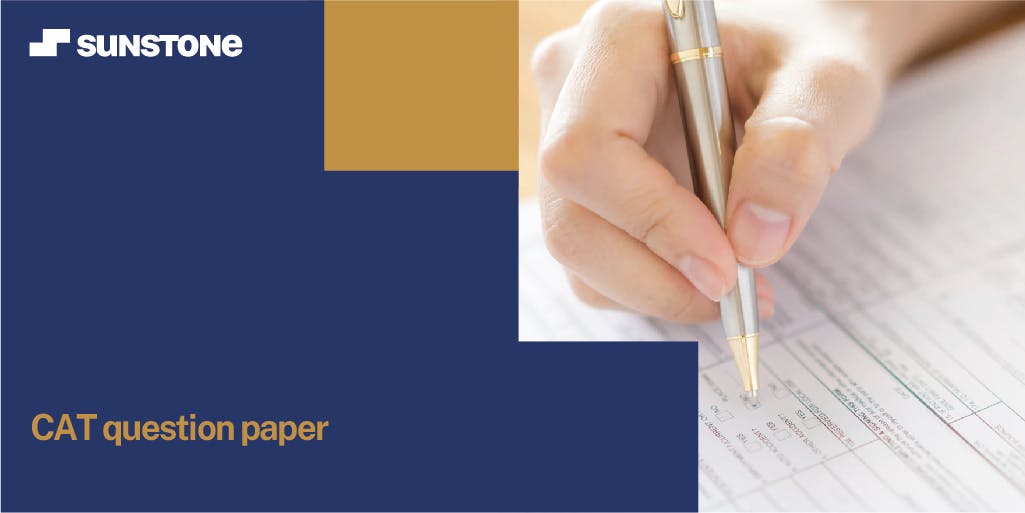5800 students unlocked their dream jobs with UG/PG programs in top colleges. Apply Now!
Solving CAT question papers from previous years has been been a tried and proven method to ace your upcoming CAT exam. The CAT exam papers from the last five years give you a clear picture of the exam pattern, important topics, and level of difficulty. This allows you to prepare and focus on the different topics strategically.
You can familiarize yourself with the CAT question paper pattern by solving previous years' question papers as well as CAT mock tests. This allows you to identify your strength and weaknesses.
In this article, we will provide you with the CAT exam papers from previous years. Move to the next section to find CAT Question Papers PDFs to identify the pattern of questions and plan your preparation accordingly!
CAT Previous Years' Papers
CAT Paper Analysis
Now that you have gone through the CAT papers from previous years, let us look at the analysis of each of these papers.
CAT 2015 - Paper Analysis
Although the 2015 CAT question paper was in tandem with the CAT sample papers that were provided on the official CAT website, there were several surprises that it presented.
Verbal Ability and Reading Comprehension:
- Difficulty level: Easy to moderately difficult
- Length: Lengthy (paper was dominated by questions from Reading Comprehension)
- How to ensure high percentile: Correct attempt of at least 20 questions could help secure a 97+ percentile
Data Interpretation and Logical Reasoning:
- Difficulty level: Moderate
- Length: Demanded great attention as one question based on set theory was quite difficult
- Strategy: This section could be solved with some good amount of prior practice
Quantitative Ability:
- Aim of the questions: To test knowledge of the basics
- Noticeable change: Absence of questions based on numerical calculations
- How to secure a high percentile: An attempt of 24-28 questions could ensure a high percentile
CAT 2016 - Paper Analysis
Here is an in-depth analysis of the CAT question paper of 2016:
Verbal Ability and Reading Comprehension:
- This section contained vocabulary heavy questions
- Most of the questions in this section were non-MCQ or TITA type
- Some of the topics included jumbled sentences, fill in the blanks, sentence correction, etc
Data Interpretation and Logical Reasoning:
- A good mix of logical reasoning and data interpretation questions were present
- In a total of 32 questions, there was a 50-50 division of questions between DI and LR
- The DI questions were divided into 4 sets, in terms of bar diagrams, pie charts, data tables, etc
Quantitative Ability:
- Difficulty level: Medium to difficult
- Noticeable changes: Fewer non-MCQ questions
- According to the CAT exam candidates, there were a few incorrect questions from this section
CAT 2017 - Paper Analysis
The overall difficulty level of the 2017 paper was moderate, as it followed the same pattern of the 2016 paper. The number of questions and difficulty level of each section remained the same.
Let us look a little deeper into the section-wise analysis of the paper.
Verbal Ability and Reading Comprehension:
- Difficulty level: Easy
- Question composition: From a total of 34 questions, 5 were Reading Comprehensions, 3 were para summaries, and 3 were para jumbles
- An attempt of at least 25 questions, with a 90% accuracy is sufficient to secure a high percentile
Data Interpretation and Logical Reasoning:
- The 2017 CAT question paper contained the toughest LRDI section
- Presence of several time-consuming cases and logical DI
- A score of above 15, with an accuracy rate of 85% is enough to count as a good attempt
Quantitative Ability:
- Difficulty level: Easy
- Question composition: Maximum questions were from algebra, geometry, and arithmetic
- A score of above 28, with an accuracy level of 85% is considered as a commendable attempt
CAT 2018 - Paper Analysis
There were some overall changes noticed in the pattern of the 2018 CAT question paper.
- There was a total of 27 non-MCQ questions
- The DILR section was the most difficult
- The QA section was heavy on numerical calculations
- Minor structural changes were also noticed in the VARC section
Verbal Ability and Reading Comprehension:
- Was comparatively easier than the other two sections
- 24 questions were based on Reading Comprehension
- A total of 7 non-MCQ questions were included
Data Interpretation and Logical Reasoning:
- This was the most difficult section of this paper
- There were 8 sets with 4 questions in each
- Around 15 questions from this section could be solved easily with some practice
Quantitative Ability:
- Difficulty level: Moderate
- The quantitative section demanded heavy calculations
- This section was dominated by geometry and arithmetic.
With the help of the analysis of previous years' CAT question papers you can:
- Understand the pattern of the exam
- Gauge the level of difficulty of each section
- Identify important topics and focus on them
Benefits of Solving CAT Previous Year Papers
Solving previous year papers is one of the most effective ways of preparing for any competitive exam, and CAT is no different. Instead of reading books all day, attempting previous years papers is a better use of your time. They say working smarter is better than working harder, and it couldn't be more true in this case.
Solving previous year questions will help you know what kind of questions come up and how to tackle them. This will give you a more holistic viewpoint of the exam and the level of your preparation.
Summing up how solving previous year papers benefits you-
- Provides higher value for your time.
- More efficient.
- Helps you figure out what kind of questions are generally asked.
Also Read: CAT Exam Dates | CAT Sample Papers | CAT Mock Tests
FAQs About CAT Question Papers
Is the CAT exam really tough?
Who prepares the CAT question paper?
Does CAT release the question paper?
How many questions are there in CAT?
For the 2021 CAT exam, the pattern from last year will be continued with 76 questions and a time span of 120 mins. The questions are further divided into three sections with VARC containing 26 questions, DI & LR containing 24 questions, and QA containing 26 questions.
HELP
Take the first step towards your dream job.
ABOUT THE AUTHOR

